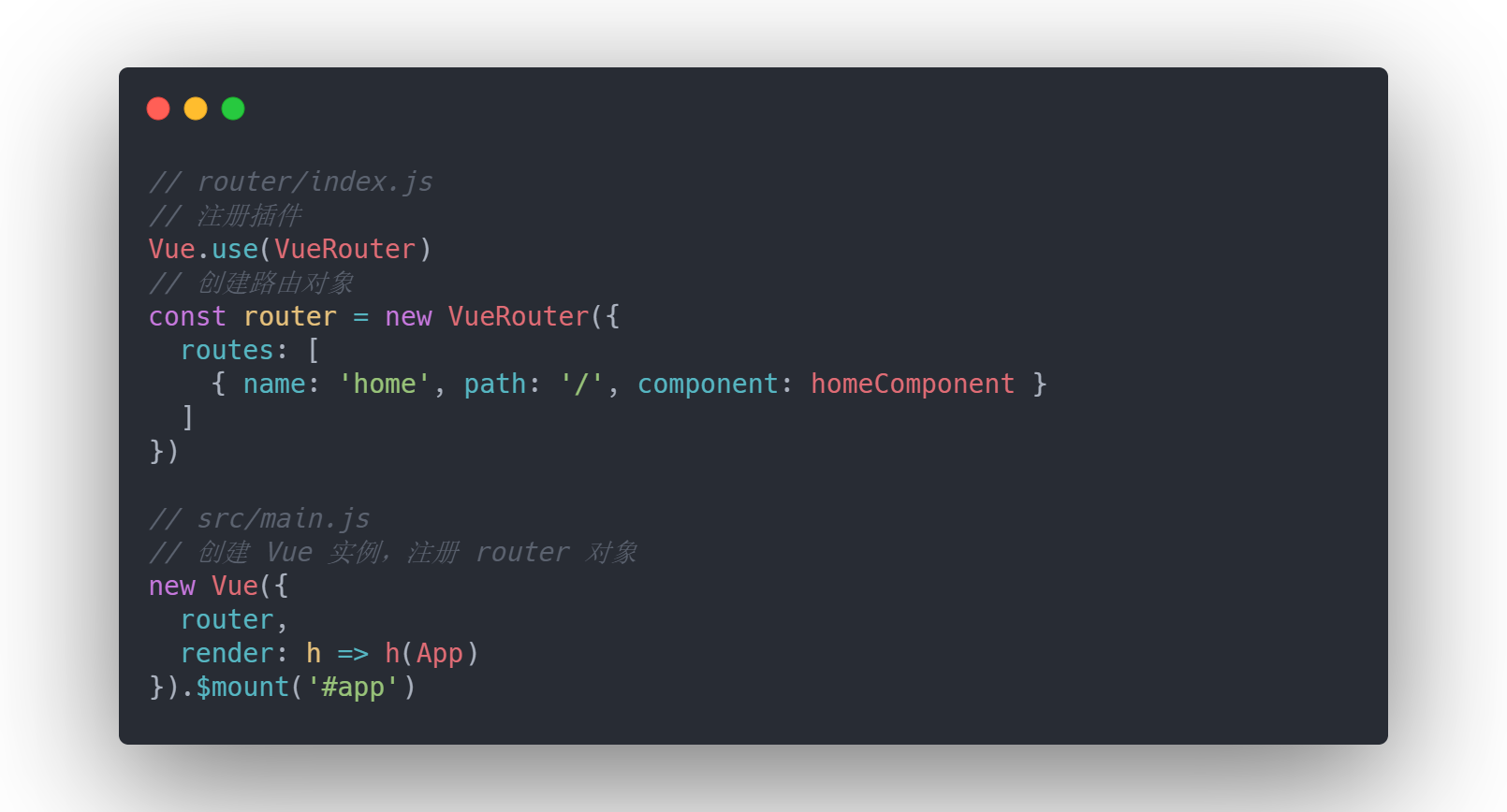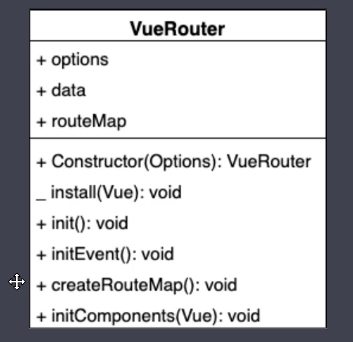# 手写实现一个 VueRouter
# 两种路由模式的实现思路
# Hash 模式
URL中#后面的内容作为路径地址- 监听
hashchange事件 - 根据当前路由地址找到对应组件进行重新渲染
# History 模式
- 通过
window.history.pushState()方法改变地址栏 - 监听
popstate事件 - 根据当前路由地址找到对应组件重新渲染
# 关于 VueRouter 模拟实现的分析

Vue.use() 的参数支持传入一个函数或对象。如果传入函数,Vue.use() 会调用这个函数。如果传入对象,Vue.use() 内部会调用这个对象的 install 方法。
下面是 VueRouter 的类图:

类图一共分为三部分,上面部分是类的名称,中间部分是类的属性,下面部分是类的方法。
VueRouter 有三个属性,分别是 options、data 和 routeMap。
options属性的作用是记录构造函数中传入 的对象,传入的对象包含了routes属性,也就是路由规则。routeMap是一个对象,它是用来记录路由地址与组件的对应关系的,将来会把路由地址解析到routeMap中来。data是一个对象,它有一个属性current,这个属性是用来记录当前路由地址的。此处设置有一个data对象的目的是我们需要一个响应式的对象。 路由地址发生变化之后组件要自动更新,需要调用Vue.observable()方法。
VueRouter 类图方法中 + 号是对外公开的方法,- 号是静态方法。其中 install 就是静态方法,用来实现 Vue 的插件机制。init 方法是用来调用后面的三个方法的。initEvent 方法用来监听 popstate 事件,用来监听浏览器历史变化。createRouteMap 方法是用来初始化 routeMap 属性的,能够把构造函数中传入的路由规则转化为键值对的形式存储到 routeMap 里面。routeMap 是一个对象,其中键就是路由地址,值是地址对应的组件,在 <router-view /> 这个组件中会使用到 routeMap。initComponents 方法是用来创建 <router-link /> 和 <router-view /> 这两个组件的。
# 实现 VueRouter 的 install 方法
Vue.use() 方法注册 VueRouter 的时候自动调用 VueRouter 的 install
静态方法。下面模拟实现 VueRouter。
install 方法中要做几件事:
- 判断当前插件是否已安装
- 把
Vue的构造函数记录到全局变量,因为将来需要在VueRouter的实例方法中使用这个Vue构造函数,比如在创建<router-link />和<router-view />这两个组件的时候需要调用Vue.initComponents()方法 - 把创建
Vue实例时传入的router对象注入到所有Vue实例上,我们之前使用的this.$router就是在这时候注入到Vue实例上的,并且所有的组件也是Vue的实例
// myVueRouter.js
let _Vue = null
export default class VueRouter {
// install 静态方法参数是 Vue 的构造函数
static install (Vue) {
// 1. 判断当前插件是否已经被安装
if (VueRouter.install.installed) {
return
}
VueRouter.install.installed = true
// 2. 把 Vue 构造函数记录到全局变量
_Vue = Vue
// 3. 把创建 Vue 实例时候传入的 router 对象注入到 Vue 实例上
_Vue.mixin({
beforeCreate () {
// 判断是 Vue 根实例还是 Vue 组件,组件不需要重复注入,第一次实例化 Vue 注入即可
if (this.$options && this.$options.router) {
// 只有 Vue 根实例的 $options 选项才有 router 属性
_Vue.prototype.$router = this.$options.router
}
}
})
}
}
# 实现 VueRouter 的构造函数
// myVueRouter.js
let _Vue = null
export default class VueRouter {
...
...
constructor (options) {
this.options = options
this.routeMap = {}
// observable 方法是 Vue 提供的能够将对象定义为响应式的一个方法
this.data = _Vue.observable({
current: '/'
})
}
}
# 实现 VueRouter 的 createRouteMap 方法
createRouteMap 方法的作用是将构造函数传入的 routes 路由规则转换为键值对的形式保存在 routeMap 对象中,其中键就是路由地址,值是地址对应的组件。将来路由地址发生变化的时候,可以根据 routeMap 中的路由地址找到对应的组件,渲染到 <router-view /> 组件中来。
// myVueRouter.js
let _Vue = null
export default class VueRouter {
...
...
constructor (options) {
this.options = options
this.routeMap = {}
// observable 方法是 Vue 提供的能够将对象定义为响应式的一个方法
this.data = _Vue.observable({
current: '/'
})
}
createRouteMap () {
// 遍历所有的路由规则,把路由规则解析成键值对的形式储存到 routeMap 中
this.options.routes.forEach(route => {
// 键 -> 值
// 路由地址 -> 组件
this.routeMap[route.path] = route.component
})
}
}
# 实现 VueRouter 的 initComponents 方法
initComponents 方法是用来创建 <router-link /> 和 <router-view /> 这两个组件的。
定义一个 init 方法来调用 createRouteMap 方法与 initComponents 方法,在 install 静态方法内 Vue 根实例初始化时调用 init 方法。
// myVueRouter.js
let _Vue = null
export default class VueRouter {
// install 静态方法参数是 Vue 的构造函数
static install (Vue) {
// 1. 判断当前插件是否已经被安装
if (VueRouter.install.installed) {
return
}
VueRouter.install.installed = true
// 2. 把 Vue 构造函数记录到全局变量
_Vue = Vue
// 3. 把创建 Vue 实例时候传入的 router 对象注入到 Vue 实例上
_Vue.mixin({
beforeCreate () {
// 判断是 Vue 根实例还是 Vue 组件,组件不需要重复注入,第一次实例化 Vue 注入即可
if (this.$options && this.$options.router) {
// 只有 Vue 根实例的 $options 选项才有 router 属性
_Vue.prototype.$router = this.$options.router
// 调用定义好的 init 初始化方法
this.$options.router.init()
}
}
})
}
constructor (options) {
this.options = options
this.routeMap = {}
// observable 方法是 Vue 提供的能够将对象定义为响应式的一个方法
this.data = _Vue.observable({
current: '/'
})
}
createRouteMap () {
// 遍历所有的路由规则,把路由规则解析成键值对的形式储存到 routeMap 中
this.options.routes.forEach(route => {
// 键 -> 值
// 路由地址 -> 组件
this.routeMap[route.path] = route.component
})
}
// 实现这个 initComponents 方法时参数需要传 Vue 实例
// 也可以通过全局变量 _Vue 获取,这里为了减少该方法对外部变量的依赖,使用传递 Vue 实例的方式
initComponents (Vue) {
Vue.component('router-link', {
props: {
to: String
},
template: '<a :href="to"><slot></slot></a>'
})
}
// 定义一个初始化方法
init () {
this.createRouteMap()
this.iniComponents(_Vue)
}
}
如果是使用 vue-cli 创建出来的项目,默认是使用运行时版本,因为效率更高。上面自定义的 VueRouter 在使用时会报错,因为运行时 Vue 版本不支持 template。
# 关于 Vue 的构建版本
- 运行时版本:不支持
template模板,需要打包的时候提前编译 - 完整版:包含运行时和编译器,体积比运行时版本大
10K左右,程序运行的时候模板转换成render函数。
# 使用完整版 Vue 解决 template 模板问题
脚手架创建的根目录下,配置 vue.config.js 的 runtimeCompiler。
// vue.config.js
module.exports = {
// 选项
runtimeCompiler: true
}
# 使用运行时版本的 Vue 解决 template 问题
export default class VueRouter {
...
...
initComponents (Vue) {
Vue.component('router-link', {
props: {
to: String
},
//template: '<a :href="to"><slot></slot></a>'
render (h) {
return h ('a', {
attrs: {
href: this.to
}
}, [this.$slots.default])
}
})
}
}
运行时版本的 Vue 不支持 template 的编译,那就使用 render 函数进行渲染。
# 实现 VueRouter 的 router-view 组件
在定义 <router-view /> 组件的时候需要先找到当前路由的地址,再去 routeMap 中找到当前路由地址所对应的组件,然后借助 h 函数将组件转换成虚拟 DOM 直接返回。
export default class VueRouter {
...
...
initComponents (Vue) {
Vue.component('router-link', {
props: {
to: String
},
//template: '<a :href="to"><slot></slot></a>'
render (h) {
return h ('a', {
attrs: {
href: this.to
}
}, [this.$slots.default])
}
})
// 获取 VueRouter 实例
const self = this
Vue.component('router-view', {
render (h) {
// 获取当前路由对应的组件
const component = self.routeMap[self.data.current]
return h(component)
}
})
}
}
然后实际使用我们自定义的 VueRouter 发现点击 <router-link /> 生成的 a 标签默认会刷新页面向服务器发生请求,我们需要给渲染生成 a 标签增加点击事件,阻止默认行为。其中 pushState 方法能够改变浏览器地址栏而不向服务器发送请求。
export default class VueRouter {
...
...
initComponents (Vue) {
Vue.component('router-link', {
props: {
to: String
},
//template: '<a :href="to"><slot></slot></a>'
render (h) {
return h ('a', {
attrs: {
href: this.to
},
on: {
click: this.clickHandler
}
}, [this.$slots.default])
},
methods: {
clickHandler (e) {
// 改变浏览器地址栏 url
window.history.pushState({}, '', this.to)
// 设置当前路由地址到 VueRouter 实例的响应式属性 data 中,data 的成员改变,成员所对应的组件也会自动更新
this.$router.data.current = this.to
e.preventDefault()
}
}
})
// 获取 VueRouter 实例
const self = this
Vue.component('router-view', {
render (h) {
// 获取当前路由对应的组件
const component = self.routeMap[self.data.current]
return h(component)
}
})
}
}
# 实现 VueRouter 的 initEvent 方法
下面来实现 initEvent 方法,在这个方法中需要注册一个 popstate 事件。因为当前代码没有处理浏览器的前进后退,路由地址变了而组件没有跟着变。
注意:pushState 与 replaceState 方法都是不能触发 popstate 事件的。
export default class VueRouter {
init () {
this.createRouteMap()
this.initComponents(_vue)
this.initEvent()
}
initEvent () {
window.addEventListener('popstate', () => {
this.data.current = window.location.pathname
})
}
}
# 处理 VueRouter 的不同路由模式
上面只是支持处理 history 模式,还需要支持 hash 模式。在 initEvent 方法内对路由模式进行判断,进行相对应的处理。还需要对 initComponents 方法进行修改,其中方法内定义的 <router-link> 组件需要处理 hash 路由模式。
export default class VueRouter {
...
...
initComponents(Vue) {
// 获取传入的路由模式
const mode = this.options.mode === 'history' ? 'history' : 'hash'
Vue.component('router-link', {
props: {
to: String
},
//template: '<a :href="to"><slot></slot></a>'
render(h) {
return h('a', {
attrs: {
// 增加对 hash 路由模式的处理
href: mode === 'history' ? this.to : `/#${this.to}`
},
on: {
click: this.clickHandler
}
}, [this.$slots.default])
},
methods: {
clickHandler(e) {
// hash 模式下不需要重写 a 标签默认行为,这里直接返回
if (mode === 'hash') return
// history 模式下改变浏览器地址栏 url
window.history.pushState({}, '', this.to)
// 设置当前路由地址到 VueRouter 实例的响应式属性 data 中,data 的成员改变,成员所对应的组件也会自动更新
this.$router.data.current = this.to
// history 模式下阻止 a 标签默认行为
e.preventDefault()
}
}
})
...
...
}
initEvent () {
// 对路由模式的判断以及处理,对浏览器前进后退的处理
if (this.options.mode && this.options.mode === 'history') {
// 监听浏览器前进后退触发的 popstate 事件,手动更改 current,触发更新组件视图
window.addEventListener('popstate', () => {
this.data.current = window.location.pathname
})
} else {
// hash 模式
// 判断是否已存在 hash 符号,不存在则添加 #/
window.location.hash ? '' : window.location.hash = '/'
// 第一次加载的时候对 hash 路由进行渲染
window.addEventListener('load', () => {
this.data.current = window.location.hash.slice(1)
})
// 监听 hash 变化
window.addEventListener('hashchange', () => {
// 这里因为是 hash 模式,所以 location.hash 的值是 #/ 开头的字符串
// 这里用 slice 截取去掉 #,赋值给 current,根据 routeMap 键值对触发组件的渲染
this.data.current = window.location.hash.slice(1)
})
}
}
}
# 完整 VueRouter 代码
下面是模拟实现的一个简单的 VueRouter 完整代码,尝试用模拟的 VueRouter 去代替 vue-cli 新创建出来的项目所引入的 vue-router,可以正常工作。
// router/index.js
// import VueRouter from 'vue-router'
import VueRouter from '../../myVueRouter'
// myVueRouter.js
let _Vue = null
export default class VueRouter {
// install 静态方法参数是 Vue 的构造函数
static install(Vue) {
// 1. 判断当前插件是否已经被安装
if (VueRouter.install.installed) {
return
}
VueRouter.install.installed = true
// 2. 把 Vue 构造函数记录到全局变量
_Vue = Vue
// 3. 把创建 Vue 实例时候传入的 router 对象注入到 Vue 实例上
_Vue.mixin({
beforeCreate() {
// 判断是 Vue 根实例还是 Vue 组件,组件不需要重复注入,第一次实例化 Vue 注入即可
if (this.$options && this.$options.router) {
// 只有 Vue 根实例的 $options 选项才有 router 属性
_Vue.prototype.$router = this.$options.router
// 调用定义好的 init 初始化方法
this.$options.router.init()
}
}
})
}
constructor(options) {
this.options = options
this.routeMap = {}
// observable 方法是 Vue 提供的能够将对象定义为响应式的一个方法
this.data = _Vue.observable({
current: '/'
})
}
init() {
this.createRouteMap()
this.initComponents(_Vue)
this.initEvent()
}
createRouteMap() {
// 遍历所有的路由规则,把路由规则解析成键值对的形式储存到 routeMap 中
this.options.routes.forEach(route => {
// 键 -> 值
// 路由地址 -> 组件
this.routeMap[route.path] = route.component
})
}
// 实现这个 initComponents 方法时参数需要传 Vue 实例
// 也可以通过全局变量 _Vue 获取,这里为了减少该方法对外部变量的依赖,使用传递 Vue 实例的方式
initComponents(Vue) {
// 获取传入的路由模式
const mode = this.options.mode === 'history' ? 'history' : 'hash'
Vue.component('router-link', {
props: {
to: String
},
//template: '<a :href="to"><slot></slot></a>'
render(h) {
return h('a', {
attrs: {
// 增加对 hash 路由模式的处理
href: mode === 'history' ? this.to : `/#${this.to}`
},
on: {
click: this.clickHandler
}
}, [this.$slots.default])
},
methods: {
clickHandler(e) {
// hash 模式下不需要重写 a 标签默认行为,这里直接返回
if (mode === 'hash') return
// history 模式下改变浏览器地址栏 url
window.history.pushState({}, '', this.to)
// 设置当前路由地址到 VueRouter 实例的响应式属性 data 中,data 的成员改变,成员所对应的组件也会自动更新
this.$router.data.current = this.to
// history 模式下阻止 a 标签默认行为
e.preventDefault()
}
}
})
// 获取 VueRouter 实例
const self = this
Vue.component('router-view', {
render(h) {
// 获取当前路由对应的组件
const component = self.routeMap[self.data.current]
return h(component)
}
})
}
initEvent() {
// 对路由模式的判断以及处理,对浏览器前进后退的处理
if (this.options.mode && this.options.mode === 'history') {
// 监听浏览器前进后退触发的 popstate 事件,手动更改 current,触发更新组件视图
window.addEventListener('popstate', () => {
this.data.current = window.location.pathname
})
} else {
// hash 模式
// 判断是否已存在 hash 符号,不存在则添加 #/
window.location.hash ? '' : window.location.hash = '/'
// 第一次加载的时候对 hash 路由进行渲染
window.addEventListener('load', () => {
this.data.current = window.location.hash.slice(1)
})
// 监听 hash 变化
window.addEventListener('hashchange', () => {
// 这里因为是 hash 模式,所以 location.hash 的值是 #/ 开头的字符串
// 这里用 slice 截取去掉 #,赋值给 current,根据 routeMap 键值对触发组件的渲染
this.data.current = window.location.hash.slice(1)
})
}
}
}
